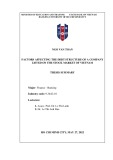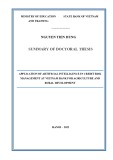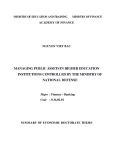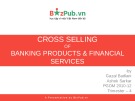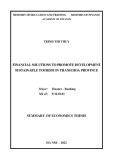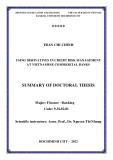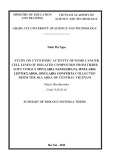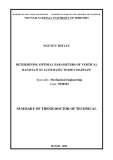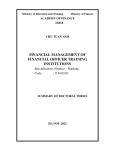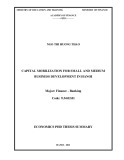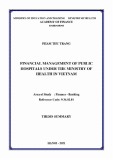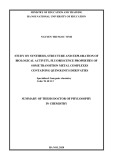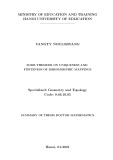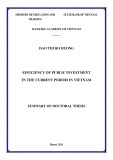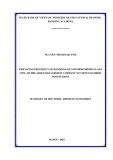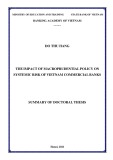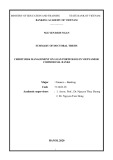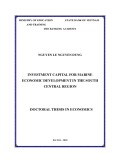MINISTRY OF EDUCATION AND TRAINING THE STATE BANK OF VIETNAM
BANKING UNIVERSITY OF HO CHI MINH CITY
NGUYEN TRUNG HIEU DEVELOPING THE CORPORATE CREDIT RATING
MARKET IN VIETNAM
SUMMARY OF THESIS DOCTOR OF ECONOMICS
Major: Finance - Banking
Code: 9 34 02 01
Science instructors: Associate Prof. Dr. Ha Thi Thieu Dao
Ho Chi Minh City - 2021
1
SUMMARY
The thesis proposes research and application of relevant theories in assessing the intended behavior of individual investors and listed companies for the use of CRA services in Vietnam to be able to propose recommendations for the development of the market for corporate credit rating market in Vietnam. The thesis has analyzed the current situation of the corporate credit rating market in Vietnam and compared with other Asian countries. The thesis also surveyed the opinions of individuals, thereby giving a structural equation model of the intended behavior to accept and use the corporate credit rating of individuals in Vietnam. At the same time, the thesis also acknowledges opinions of corporates in Vietnam about their assessment of CRA in Vietnam and plans to use corporate credit rating services. The research results show that the Vietnamese corporate credit rating market is just in the beginning stage, facing many difficulties and has not yet obtained significant results. Compared to other Asian countries, Vietnam has "come from behind" and still has many problems to be solved. However, individuals' demand for corporate credit rating services is quite evident and tends to increase over time. At the same time, the corporates' assessment of the reputation of a credit rating agency in Vietnam is not really high, but opinions on the future prospects are being appreciated and and willingness to pay service fees also provides a remarkable result in terms of market conditions. From the research results on the SEM model for the intended behavior of individuals and corporates in the market, the thesis has made recommendations to develop the corporate credit rating market in Vietnam.
2
CHAPTER 1. INTRODUCTION TO THE STUDY
1.1. REASONS FOR STUDY SELECTION
Born in the mid-19th century when Henry Varnum Poor published its first credit rating reports (1860), credit rating agencies have proven their important role in world financial markets (Cantor, 2004). White (2013) found that more and more research on corporate credit rating markets and CRAs, and credit rating activities has played an important role in the development of financial markets around the world.
However, after the worldwide financial crisis of 2007 - 2008, many authors have argued that the high but uncertain rating results for modern financial products played a large part has contributed largely to the turmoil of the world economy (Hunt, 2009).
According to Cantor (2004), the researches related to corporate credit rating activities often focus on solving a problem posed in practice and can be divided into three basic problems: (i) studies to examine and assess the corporate credit rating market in order to explain the monopoly situation in the market or provide arguments for change or regulation from regulators; (ii) research revolves around evaluating the role and effectiveness of corporate credit rating agencies in the market; (iii) focus on the behavior of CRAs in the market and ethical risks. However, the studies related to the credit rating market just starting out like Vietnam are not specific. Studies have not yet demonstrated whether the need for credit rating is really necessary under limited information conditions.
3
In Vietnam, Vuong Quan Hoang and Tran Tri Dung (2009) pointed out the situation that until 2000, Vietnam still did not have a secondary bond market, despite the issuance of government bonds and corporate bonds. After nearly 20 years of operation, corporate bonds have not really developed (VCBS, 2016). The bond market has not been linked to the corporate credit rating market (HNX, 2016), so the bond market is still more of a credit market than a debt instrument investment markets like countries in the world. This entails an urgent need for corporate credit rating in Vietnam.
Decree 163/2018/ND-CP of the government has created a more open legal corridor for the corporate bond market. This raises the need for more transparency in the market to boost growth, and one of the key factors to consider is that Vietnam needs to have CRAs operating effectively soon (Nguyen Viet Cuong, 2019).
Size of corporate bond issuance in Vietnam has experienced a strong growth from 2016 to 2020 (Ministry of Finance, 2020). These figures show that the growth potential of the corporate bond market in Vietnam is huge, but for many reasons, this market has not developed as expected. The main reason is the absence of corporate CRAs and corporate credit rating activities in the Vietnamese market (Nguyen Thi Minh Hue and Nguyen Thi Thanh Huong, 2020). Le Quang Cuong (2007) argues that Vietnam needs to build a corporate credit ratings market, but there are still many controversies like HNX (2016).
The Vietnamese credit rating market for a long time has only been established by a few CRAs. However, these legal DCRAs in Vietnam have only produced a very limited number of ratings reports
4
after more than two years of establishment, further proving the difficulty in developing the market. Not only that, the corporate credit rating market in Vietnam is not enough to attract the attention of GCRAs with the number of businesses rated by GCRA is very small. Therefore, the current situation poses many challenges for the development of corporate credit rating market (PTR, 2019; Nguyen Thi Kim Thanh, 2011).
From the above-mentioned researches, it shows that major problems have been concerned and found solutions. However, the research related to the corporate credit rating market is just in the starting stage like Vietnam is not specific. Therefore, research and specific consideration of the corporate credit rating market in Vietnam and market development is essential.
1.2. RESEARCH OBJECTIVES AND RESEARCH QUESTIONS
The general objective of this study is to apply the relevant theories in assessing the intended behavior of individual investors, listed companies to the use of corporate credit rating services in Vietnam. In order to be able to make recommendations to develop the corporate credit rating market in Vietnam. To achieve the general objective, the thesis implements specific research objectives, including: (i) analyzing the current situation of corporate credit rating market in Vietnam; (ii) determining the impacting factors and the extent to which the intended to use of services by corporates and individuals on the corporate credit rating market in Vietnam; (iii) proposing recommendations that can be made from research results
5
to develop the corporate credit rating market in Vietnam. Corresponding to these goals, the research questions considered are:
What is the current situation in the legal context and operations of corporate CRAs in the Vietnamese corporate credit rating market?
Are individual investors, listed companies in Vietnam planning to use corporate credit rating services?
What factors influence their intention to behave in order to consider developing a corporate credit rating market in Vietnam?
What recommendations can be proposed from the research results to develop the corporate credit rating market in Vietnam?
1.3. OBJECT AND SCOPE OF THE STUDY
The research object is the intended behavior of an individual investor or a listed enterprise with regard to the use of corporate credit rating services in Vietnam that may consider the impact on the development of the corporate credit rating market. The scope of the study with the factors belonging to the participants is collected information in the period 2014 - 2020. For the primary data, the study is collected from the questionnaires answered from the research sample. For the secondary data are mainly collected from the sources of the Government of Vietnam, ADB, WB, IMF, ACRAA.
1.4. RESEARCH METHODS AND DATA
This study uses a combination of analytical methods to enable multi- dimensional perspectives from market participants as well as factors affecting the development of the corporate credit rating market in
6
Vietnam. In which, the main method is descriptive statistical method and structural equation modeling method. To increase the reliability of research results with small sample sizes, the Bayes SEM estimation method was used to compare with ML - SEM.
1.5. CONTRIBUTION OF THE STUDY
In practical terms, the study aims to contribute empirical evidence to the rating from corporates and investors in the market on corporate credit rating in Vietnam.
Theoretically, the research generalizes the theories related to the market and develops the market for corporate credit rating. The study adds new points on how to approach feedback from market participants who are individuals and businesses to CRA in particular and the corporate credit rating market in general ...
1.6. STRUCTURE OF THE THESIS
Chapter 1. Introduction to research
Chapter 2. Theoretical basis for the development of the corporate credit rating market
Chapter 3. Research method
Chapter 4. Research results and discussion
Chapter 5. Conclusion and recommendations on developing the corporate credit rating market in Vietnam
7
CHAPTER 2. THEORETICAL BASIS OF DEVELOPING THE CORPORATE CREDIT RANK MARKET
2.1. OVERVIEW OF THE DEVELOPMENT CORPORATE CREDIT RATING MARKET
2.1.1. Corporate credit rating market and development of corporate credit rating market
2.1.1.1. Corporate credit rating and corporate credit rating market
Corporate credit rating is a process of evaluating and categorizing credit levels relative to different levels of risk, each of which is a clear reflection of the business's ability to pay off debt. At the same time, credit rating is also a process of using known and current information to forecast future results. (Ong, 2003). A corporate credit rating market is a market formed by the participation of investors, issuers, credit rating agencies and other stakeholders to providing corporate credit rating services and performing the role of information intermediary markets in the economy (European Union, 2016).
2.1.1.2. Development corporate credit rating market
In this study, the viewpoint of White (2013) in conjunction with Todhanakasem (2001) is used to clarify the development of the corporate credit rating market in Vietnam through assessing the full participation of stakeholders in the market both on the supply and demand side, creating a positive response on the effectiveness of corporate credit rating and expanding operations CRAs in the market.
8
Ashcraft, Schuermann (2008), White (2002), White (2013) affirmed that the development of corporate credit rating market in general and the CRAs in particular has important implications. In particular, corporate credit rating market in Vietnam will effectively perform the main function role of providing information services and providing monitoring services in the financial market and the economy. In which the function of providing information services is the primary, first and important function.
2.1.2. Participants in corporate credit rating market
2.1.2.1. Credit rating agencies
2.1.2.2. Corporates
2.1.2.3. Entities use corporate credit rating results
-The investors
- Investment banks, securities companies
- Enterprises and financial institutions conducting lending activities
2.1.2.4. Government regulators
2.1.3. Development of services on the corporate credit rating market
According to White (2010), S&P (2019), MIS (2019), CRA's business rating services can be very diverse and there are some differences between CRAs, but the core services are still quite similar. In general, the basic products are rating of issuers of debt obligations, rating of specific debt obligations and other services related to corporate credit rating.
9
2.1.3.1. Issuer Credit Rating
2.1.3.2. Issue Credit Rating
2.1.3.3. Other services related to corporate credit rating
2.1.4. Development of business models in the corporate credit rating market
2.1.4.1. Investor-pay model
2.1.4.2. Issuer-pay model
2.1.4.3. Subscription model
2.2. THEORY RELATED TO DEVELOP CORPORATE CREDIT RATING MARKET
2.2.1. Theory of information asymmetry and signaling theory
theory, transaction costs and information
2.2.2. Agent intermediaries
2.2.3. Theory of the organization's reputation
2.2.4. Theory of planned behavior
2.3. RESEARCH RELATED TO DEVELOP CORPORATE CREDIT RATING MARKET
2.3.1. Developing the corporate credit rating market is based on the establishment and expansion of corporate CRAs
2.3.2. Developing the corporate credit rating market based on the need for information on corporate credit rating of investors
10
2.3.3. Developing the corporate credit rating market is based on increasing the impact of corporate credit ratings on the financial market
2.3.4. Developing the corporate credit rating market is based on increasing confidence from issuers in the reputation of CRAs
2.3.5. Developing the corporate credit rating market is based on the increased competitiveness of the market among CRAs
2.4. RESEARCH GAP ON PREVIOUS STUDY
A problem posed in previous studies is the difficulty in connecting previous studies to match research objectives and the current situation of Vietnam. In the author's ability to learn and review, the previous studies lacked studies that specifically consider the development of the corporate credit rating market fully in terms of market and stakeholders.
Most of the previous studies were based on methods that used past rating result data, to set up the game to make assumptions to explain the functioning of CRAs. Then, the previous studies are mostly looking at the impact on the stakeholders on the market of CRA in developed markets such as the United States, Europe with long and complete data intervals. Given the current situation of CRAs in Vietnam, this approach is almost impossible to apply since the market did not have sufficient data on the corporate credit rating in the past. Therefore, these studies are more suitable for developing theoretical basis for research than applying experimental research. In some emerging market research, the approach is based on a small number of CRAs in the same country. Therefore, recommendations
11
to develop the corporate credit rating market based on the experiences of the authors are mainly. Finally, there is a shortage of direct research on CRAs and developing the corporate credit rating market in Vietnam. With the limited accessibility of the author himself, researches on developing the corporate credit rating market are in Vietnam almost very limited.
the validity of
In terms of methodology, the positivist approach attempts to test used reasoning through an examination and interpretation process (Hirschheim & Klein, 1992). Specifically, through building hypotheses, models or causal relationships in structures and using probable quantitative methods to test relationships, at the same time the researcher has can freely explain goals (Chen & Hirschheim, 2004). Therefore, this study will follow an empirical approach in which data is collected through survey method to examine the impact between the independent and dependent variables. The research applies quantitative research method because it helps to test, theoretical establish reliability and evaluate hypothesis based on tests and measurement techniques (Blumberg, Cooper & Schindler, 2005). In addition, the scales are built on previous studies, have clearly laid out the relationship between the necessary structures, so it is difficult to achieve through qualitative methods (Collis & Hussey, 2003).
12
CHAPTER 3. RESEARCH METHODS
3.1. RECOMMENDED RESEARCH PROCESS
Source: Authors synthesized and suggested
13
Figure 3.1. Recommended research process
3.2. RESEARCH MODELS
3.2.1. Research model for the intended behavior of using corporate credit rating by individuals in Vietnam
Source: Authors synthesized and suggested
Figure 3.2. Research models and hypotheses for the intended behavior of using corporate credit rating of individuals in Vietnam
14
3.2.2. Research model for CRA reputation assessment and the intended behavior of Vietnamese companies to use a paid corporate credit rating service
Source: Authors synthesized and suggested
Figure 3.3. Research models and hypotheses for CRA reputation assessment and the intended behavior of Vietnamese companies to use corporate credit rating service
3.3. DATA AND RESEARCH SAMPLE
3.3.1. Define the study population and study sample
15
For individuals in Vietnam, the study considers the surveyed subjects as individuals including investors, analysts, researchers, teachers, and business leaders in Vietnam. This is a very wide research overall, so to limit the scope and suit the ability to conduct the survey, individuals in Ho Chi Minh City, Hanoi, Da Nang and Can Tho were selected. For corporates in Vietnam, this is also a very wide research overall and it is really difficult to access and record their opinions. So to limit the scope, the study uses the information provided by the existing data of the information support organization and the author collects himself, then selects the appropriate business leaders to send out questionnaire.
3.3.2. Data collection and sample characteristics
questionnaires were developed through
expert The survey/consultation and adjusted before the official survey. The author performed data analysis through tools such as descriptive statistics of the survey sample, the results are presented in Appendix.
3.4. DATA ANALYSIS METHOD
3.4.1. Check the reliability of the scale
3.4.2. Explore factor analysis
3.4.3. Confirmation factor analysis and structure model ML- SEM
3.4.4. Model analysis of the Bayesian SEM
3.4.4.1. B-SEM and some additional advantages for ML-SEM
Comparison of ML-SEM and B-SEM has been published in studies of many fields such as management, economics, finance, tourism ...
16
(Zyphur & Oswald, 2015, Assaf et al., 2018). The previous studies basically suggested that ML-SEM and B-SEM give roughly identical results with continuous variables, large sample sizes and all parameters having a normal distribution (Van de Schoot & et al., 2014). However, in this study with the scale of variables using the Likert scale and the number of samples only about less than 300 samples model, B-SEM will promote its advantages.
3.4.4.2. Analysis and testing in the B-SEM model
As suggested by Gelman et al. (2014), three steps of B-SEM analysis were performed as follows: 1) Establish a full probability model including a prior distribution. 2) Estimate the posterior distributions. 3) Evaluate the suitability of the model and interpret the results.
CHAPTER 4. RESULTS AND DISCUSSION
4.1. BACKGROUND OF THE CORPORATE CREDIT RATING IN VIETNAM
4.1.1. Regulations of laws and policies related to the development of the market for corporate credit rating in Vietnam
4.1.2. CRA activities in the Vietnamese market
4.1.2.1. DCRA activities in the Vietnamese market
Evaluation of the level of trust, reputation and reputation of organizations with rating activities in Vietnam in the period prior to 2014 (CRV, Vietnamcredit, Credit Ratings Vietnamnet Center) shows that these organizations are established only in a short time, little confidence in the market can be established, the organizations
17
are small, the number of experts has little or no reputable experts in the assessment.
After Decree No. 88/2014 / ND-CP comes into force, with clear regulations. However, during the period of nearly 3 years from 2014 to mid-2017, there was not any CRA enterprise established in the Vietnamese market.
As of July 21, 2017, the Ministry of Finance has licensed the first CRA in Vietnam to provide corporate credit rating services under Decree No. 88/2014/ND-CP, which is Saigon Phat Thinh Rating Joint Stock Company. The DCRA in Vietnamese market to quickly bring to the market of services is the orporate credit rating and credit rating of debt instruments (PTR, 2019). PTR also announced the fees for the rating. Looking at the current situation of DCRAs in Vietnam, it can be seen that the development is quite slow compared to other Asian countries (ACRAA, 2018).
4.1.2.2. GCRA activities in the Vietnamese market
For GCRA, Vietnamese companies that directly use the CRA rating service are very few. Only a handful of Vietnamese firms use the service, mainly when issuing bonds to the international market. Compared to other countries, due to the weak impact of the legislation on GCRAs, it can be seen that the number of firms officially rated from GCRAs is still not much. Most of the activities of GCRAs in Vietnam are still mainly based on public information, unsolicited credit ratings and the ratings of commercial banks, financial groups rather than the corporate credit rating.
4.1.3. Macroeconomic background in Vietnam
18
It can be seen that the macroeconomic background in recent years has brought more advantages for the development of the corporate credit rating market, with the rapid growth of the corporate bond market in a short time. According to the roadmap set by the government, along with good and stable economic growth compared to the region as well as the world, the financial market still focuses on bank credit... This can be seen as appropriate to promote the development of the market for the CRA in Vietnam.
4.2. ACTION MODEL INTENDED TO USE CITIZENDS OF INDIVIDUALS IN VIETNAM
Source: Authors synthesized from research results
19
Figure 4.1. ML-SEM linear structure model of factors affecting the intended to use CCR services in Vietnam
In order to reinforce the results of the ML-SEM model of factors affecting the intended needs of using the CSR services in Vietnam with the sample size not too large, the B-SEM was applied. The results show that B-SEM satisfies the conditions of convergence, autocorrelation, bias, sensitivity test ... The hypotheses of the original model are accepted.
Table 4.1. Results of the B-SEM model of the behaviors intended to be used CCR services by individuals in Vietnam
Mean
Min Max
Regression weights
Standardized estimates
95% Lower bound
95% Upper bound
ATT <-- BB
0,073
0,057
0,092
0,037 0,113
0,595
SN <-- NB
0,052
0,032
0,072
0,017 0,091
0,380
PBC <-- CB
0,773
0,659
0,893
0,536 1,032
0,716
IT <-- ATT
0,370
0,267
0,480
0,189 0,585
0,546
IT <-- PBC
0,274
0,192
0,364
0,125 0,428
0,439
IT <-- SN
0,301
0,219
0,394
0,107 0,468
0,442
Source: Authors synthesized from research results
4.3. MODEL REPUTATION AND INTENTION TO USE CREDIT RATING SERVICE OF CORPORATES FOR CRA IN VIETNAM
20
Source: Authors synthesized from research results
Figure 4.2. Model of ML-SEM reputation and intention to use credit rating services of corporates for CRA in Vietnam
The B-SEM model evaluates the reputation and intention to use the credit rating services of corporates for CRA in Vietnam, which is carried out in turn through the steps and meets the conditions of tests... The convergence, self-correlation, errors, sensitivity hypotheses set forth by the original model are also fully accepted.
21
Table 4.2. Results of the reputable B-SEM model and enterprise's intention to use CSR services for CRA in Vietnam
Mean
Min
Max
95% Lower bound
95% Upper bound
Standardized estimates
Regression weights
Trust <--Reputation 0,695
0,550
0,842
0,447
1,028
0,648
0,442
0,294
0,608
0,186
0,795
0,644
Identification <-- Reputation
0,578
0,422
0,746
0,312
0,906
0,472
Identification <-- Trust
0,395
0,290
0,504
0,177
0,562
0,462
Intention <-- Identification
Intention <--Trust
0,401
0,275
0,524
0,206
0,623
0,602
0,295
0,177
0,404
0,095
0,460
0,297
Intention <-- Commitment
Source: Authors synthesized from research results
4.4. DISCUSSION OF RESEARCH RESULTS
4.4.1. Results of the behaviors intended to be used CCR by individuals and the influencing factors in the model
4.4.2. Results of assessing the reputation, intended use of corporates for CRA in Vietnam and the factors affecting the model
22
CHAPTER 5. CONCLUSION AND RECOMMENDATIONS FOR DEVELOPING CORPORATE CREDIT RATING MARKET IN VIETNAM
5.1. CONCLUSION
The research is based on the theoretical basis and related studies to be able to analyze the current situation and prospects of the market development of the corporate credit rating market in Vietnam. In which, the thesis presented the results of analyzing market context on regulations, policies and activities of DCRAs and even GCRAs in Vietnam in different stages. The thesis also points out the advantages in the macro context such as the development of the corporate bond market or economic growth ... First, there are still many difficulties and not get significant results. Compared to other Asian countries, Vietnam has "started later" and there are still many issues to be resolved about market participants, legal regulations as well as the capabilities of DCRAs in the market.
individuals have difficulty
it is very to have an
The individual's demand for using corporate credit rating market is in accessing quite obvious. As information important information, intermediary, which is a CRA. This is the basis for the next studies to consider the development direction of the market for the corporate credit rating market in Vietnam. The extent to which individuals' intention to use corporate credit ratings is influenced by both attitudes, subjective norms, and perceived behavioral control. At the same time, through strict compliance with recommendations and guidelines for the TPB model, the study has examined the effects of behavioral beliefs, normative beliefs and behavioral control beliefs
23
in the corresponding scales. The results show that with indirect measures in the model, the control beliefs behavior has a strong impact on control perception and behavioral beliefs, normative beliefs also affect attitudes toward the behavior.
organizational rating method,
Regarding the opinions of businesses, the factors affecting the reputation of CRA in Vietnam include products and services, innovation, governance, independence, organization's leadership and performance. At the same time, the study also demonstrated that the reputation of CRA has a clear impact on CRA's trust and identity of CRA organizations. This will impact the intention to use corporate credit rating services of enterprises in Vietnam together with the commitment factor. The study also shows that the business prospects of CRAs are well appreciated by enterprises and if CRA's activities are effective, CRA establishes reputation in the market, enterprises will be willing to pay fees to be provided with corporate credit rating services.
Not only that, the reputation of CRA with survey results shows that the score of the reputation scale is only evaluated at an average level, showing that the companies have confidence in the reputation of CRA in Vietnam is not really high rating. However, in the opposite direction, future assessments of corporate CRA are mostly high. This shows that companies are currently confused with using CRA's services, but in the coming future they will still trust and use CRA's products and services. Thus, the business prospects of CRAs are well appreciated by businesses and if CRA's operations are effective, CRA establishes a reputation in the market, businesses will be willing to pay fees, although have higher current, to be offering
24
them. This is a remarkable result to set the stage for the development of the market for the in Vietnam.
Through discussing the results and testing the average change in opinion of corporates and individuals in Vietnam, the study has shown a change in perception, behavioral intent, and their assessment of CRA, Vietnam's corporate credit rating market in a more positive direction. That proves that markets have made certain progress and created a premise for the future development more clearly than in the previous period.
These research results basically answer research questions and objectives 1, 2 and 3. That content is also the basis for proposing possible recommendations for developing corporate credit rating market in the next section to answer the 4th research question.
RECOMMENDATIONS DEVELOPING FOR
5.2. CORPORATE CREDIT RATING MARKET IN VIETNAM
5.2.1. Continue to improve the legal regulations on the corporate credit rating market in Vietnam
5.2.1.1. Continue to complete legal provisions for compulsory credit rating when issuing corporate bonds
5.2.1.2. Complete legal regulations on corporate CRA activities
5.2.1.3. Complete legal regulations to attract the attention of domestic and foreign organizations to establish more CRA in Vietnam.
5.2.2. Implement policies to promote stakeholders to participate in the corporate credit rating market
25
5.2.3. Increasing the quality of information and training related to corporate credit rating
5.2.4. Recommended for corporate CRAs
5.2.4.1. Completing the corporate rating method
5.2.4.2. Developing credit rating products and services towards creating stable and transparent revenue sources
5.2.4.3. Apply technology innovations to aid methodology in corporate credit rating
5.2.4.4. Ensuring the principles and ethical standards in the corporate credit rating
5.2.4.5. Form a source of quality human resources, ensure the quality of management and leadership in CRA
5.2.4.6. Link CRAs with GCRA, RCRA and increase international and regional integration
5.2.5. Recommended for companies in general and issuers in particular in the corporate credit rating market in Vietnam
5.2.6. Recommendations for investors in the corporate credit rating in Vietnam
LIMITATIONS AND FUTURE RESEARCH
5.3. DIRECTIONS
Chapter 5 also pointed out the limitations of the research such as the small sample size, the difficult collection method, not showing the characteristics of the research sample and and recommendations should also be directed to more specific solutions in the future.

